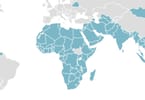Hurricane Irma may be shifting from East Florida to West Florida. What does it mean? Tourists and residents in Florida had been fleeing the East Coast seeking shelter in the west. They may be in for a dangerous surprise.
It appears, of course, all of Florida will experience hurricane force winds by Irma. The storm is expected to hit South West Florida now as a category 4 storm. The direct category 5 hit on Miami and the populated Florida East Coast may no longer be realistic, but a much stronger hit on West Florida, including Tampa and St. Petersburg, becomes more likely.
A dangerous hit on Georgia and South Caroline becomes less likely.
In the meantime, category 5 storm is battering the Northern Coast of Cuba and may have already done devastating damages.
The National Hurricane Center issued this alert at 5 am Saturday morning:
The Hurricane Warning and the Storm Surge Warning are extended northward along the Florida West coast from Anclote River to Chassahowitzka.
The Hurricane Warning is extended northward along the Florida East coast to the Flagler/Volusia County Line.
A Tropical Storm Watch has been issued north of Fernandina Beach to Altamaha Sound, Georgia.
Additional Watches and Warnings may be required for portions of the coasts of Georgia and South Carolina, as well as portions of the Florida Gulf Coast later today.
SUMMARY OF WATCHES AND WARNINGS IN EFFECT:
A Storm Surge Warning is in effect for…
* Volusia/Brevard County Line southward around the Florida peninsula to Chassahowitzka
* Florida Keys
* Tampa Bay
A Storm Surge Watch is in effect for…
* North of the Volusia/Brevard County Line to the Flagler/Volusia County line
* North of Chassahowitzka to Suwannee River
A Hurricane Warning is in effect for…
* Flagler/Volusia County Line southward around the Florida peninsula to Chassahowitzka
* Florida Keys
* Lake Okeechobee
* Florida Bay
* Cuban provinces of Camaguey, Ciego de Avila, Sancti Spiritus, Villa Clara, and Matanzas
* Central Bahamas and Ragged Island
* Northwestern Bahamas
A Hurricane Watch is in effect for…
* North of the Flagler/Volusia County Line to Fernandina Beach
* North and west of Chassahowitzka to Indian Pass
* Cuban provinces of Holguin and Las Tunas
A Tropical Storm Warning is in effect for…
* Cuban provinces of Holguin, Las Tunas, La Habana, and Ciudad de la Habana
A Tropical Storm Watch is in effect for…
* North of Fernandina Beach to Altamaha Sound
A Storm Surge Warning means there is a danger of life-threatening inundation, from rising water moving inland from the coastline, during the next 36 hours in the indicated locations. For a depiction of areas at risk, please see the National Weather
Service Storm Surge Watch/Warning Graphic, available at hurricanes.gov. Tinstructions from local officials.
At 500 AM EDT (0900 UTC), the center of Hurricane Irma was located near latitude 22.5 North, longitude 78.8 West. Irma is moving toward the west-northwest near 12 mph (19 km/h). A turn toward the northwest is expected by late today, with a turn toward the north-northwest expected tonight or on Sunday. On the forecast track, the center of Irma will move near the north coast of Cuba today, near the Florida Keys Sunday morning, and then near the southwest coast of Florida Sunday afternoon.
Maximum sustained winds are near 155 mph (250 km/h) with higher gusts. Irma is a category 4 hurricane on the Saffir-Simpson Hurricane Wind Scale. Some fluctuations in intensity are likely during the next day or two, but Irma is expected to remain a powerful hurricane as it approaches Florida.
Hurricane-force winds extend outward up to 70 miles (110 km) from the center and tropical-storm-force winds extend outward up to 195 miles (315 km).
The estimated minimum central pressure is 930 mb (27.47 inches).
STORM SURGE: The combination of a dangerous storm surge and the tide will cause normally dry areas near the coast to be flooded by rising waters moving inland from the shoreline. The water is expected to reach the following HEIGHTS ABOVE GROUND if the peak surge occurs at the time of high tide…
SW Florida from Captiva to Cape Sable…8 to 12 ft
Cape Sable to Boca Raton including the Florida Keys…5 to 10 ft
Venice to Captiva…5 to 8 ft
Suwannee River to Venice including Tampa Bay…3 to 5 ft
Boca Raton to Flagler/Volusia County line…2 to 4 ft
The deepest water will occur along the immediate coast in areas of onshore winds, where the surge will be accompanied by large and destructive waves. Surge-related flooding depends on the relative timing of the surge and the tidal cycle, and can vary greatly over short distances. For information specific to your area, please see products issued by your local National Weather Service forecast office.
The combination of a life-threatening storm surge and large breaking waves will raise water levels ABOVE NORMAL TIDE LEVELS by the following amounts within the hurricane warning area near and to the north of the center of Irma. Near the coast, the surge will be accompanied by large and destructive waves.
Ragged Island in the Bahamas…15 to 20 ft
Central and Northwestern Bahamas…3 to 6 ft
Northern coast of Cuba in the warning area…5 to 10 ft
WIND: Hurricane conditions are still occurring over portions of the central Bahamas, as well as Ragged Island. Hurricane conditions are expected to continue within the hurricane warning area along the north coast of Cuba through today. Hurricane conditions are expected in the northwestern Bahamas today, and in portions of southern and central Florida and the Florida Keys tonight and Sunday.
Hurricane and tropical storm conditions are possible within the watch area in central and north Florida by Sunday.
RAINFALL: Irma is expected to produce the following rain accumulations through Tuesday night:
Northern Cuba…10 to 15 inches, isolated 20 inches. Southern Cuba…5 to 10 inches, isolated 15 inches.
Western Bahamas…3 to 6 inches, isolated 10 inches.
The Florida Keys…10 to 20 inches, isolated 25 inches.
The Florida peninsula and southeast Georgia…8 to 15 inches, isolated 20 inches.
The eastern Florida Panhandle…3 to 6 inches, isolated 8 inches.
Rest of eastern Georgia, western South Carolina, and western North
Carolina…4 to 8 inches. Western Georgia, eastern and northern
Alabama, and southern Tennessee…2 to 5 inches.
In all areas this rainfall may cause life-threatening flash floods and, in some areas, mudslides.
TORNADOES: A few tornadoes are possible today and tonight over southern Florida.
SURF: Swells generated by Irma are affecting the southeastern
Bahamas, the Turks and Caicos Islands, the northern coast of the
Dominican Republic, and the southeast coast of the United States today. These swells are likely to cause life-threatening surf and rip current conditions. Please consult products from your local weather office.
WHAT TO TAKE AWAY FROM THIS ARTICLE:
- A Storm Surge Warning means there is a danger of life-threatening inundation, from rising water moving inland from the coastline, during the next 36 hours in the indicated locations.
- The direct category 5 hit on Miami and the populated Florida East Coast may no longer be realistic, but a much stronger hit on West Florida, including Tampa and St.
- On the forecast track, the center of Irma will move near the north coast of Cuba today, near the Florida Keys Sunday morning, and then near the southwest coast of Florida Sunday afternoon.






















